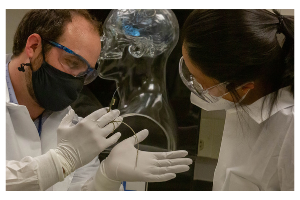LLNL-developed thin-film electrodes reveal key insight into human brain activity
Thin-film electrodes developed at Lawrence Livermore National Laboratory (LLNL) have been used in human patients at the University of California, San Francisco (UCSF), generating never-before-seen recordings of brain activity in the hippocampus, a region responsible for memory and other cognitive functions.
In a study published in the journal Nature Communications, surgeons at UCSF placed the flexible arrays on the brains of a group of patients while they were already undergoing epilepsy-related surgery. They recorded electrical signals across the exposed hippocampus while some patients were under anesthesia and others were awake, and conscious patients were given visual cues and spoke words while their neural activity was recorded. This approach allowed the researchers to detect traveling waves moving across the hippocampal surface and identify new properties about them, including how they may contribute to human cognition.
“We’ve developed an enabling technology for demonstrating a phenomenon that wasn’t really possible before,” said LLNL’s Implantable Microsystems Group Leader Razi Haque. “This challenge required the creation of novel, conformable and higher-density electrodes that allows them to be more flexible and wrap around specific, deep regions of the brain. This study is validation that the approaches we’re using are getting us consistent, usable and useful data. That’s the driver for us as engineers — to be able to build the tools that scientists can use to do new science.”
LLNL developed the 32-channel multi-electrode arrays under the Defense Advanced Research Projects Agency (DARPA)-funded SUBNETS (Systems-Based Neurotechnology for Emerging Therapies) program, which aims to improve treatments for neuropsychiatric illnesses in military service members.
UCSF neurosurgeon and scientist Edward Chang, principal investigator of the SUBNETS program, speculated the arrays could work for a separate study examining the role of the hippocampus in memory function. By recording neural activity on the exposed hippocampal surface while patients were undergoing surgery, researchers could potentially confirm the existence of traveling waves, which scientists have long theorized play an important role in routing information used to form memories and perform other cognitive processing.
Previously, the nature of traveling waves in the human hippocampus has been controversial because previous in vivo studies have relied on penetrating depth electrode recordings. Those electrodes have provided researchers with only a few single-file recording sites in various layers of the hippocampus, making it nearly impossible to understand exactly how the waves are moving across the structure, according to the paper’s lead author and UCSF neurologist Jonathan Kleen.








Leave A Comment